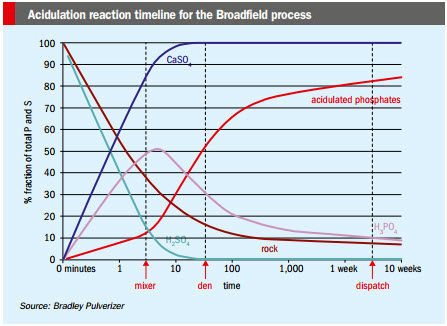Part 4 of a 5-part blog series: “The Bradley Broadfield superphosphate process”
 The Broadfield process has remained a mainstay of the global phosphate industry since its introduction in the 1930s. In Part 1, Ian Hancock, Vice President Sales & Operations, Bradley Pulverizer, provides an introduction to the Bradley Superphosphate process, in Part 2 we explore the origins of superphosphate manufacturing , and Part 3 outlines the chemical process for SSP manufacture. Click Here to download the complete article in pdf format as published by BCInsight Ltd in Fertilizer International Sept|Oct 2022, issue 510, pp. 31-35.
The Broadfield process has remained a mainstay of the global phosphate industry since its introduction in the 1930s. In Part 1, Ian Hancock, Vice President Sales & Operations, Bradley Pulverizer, provides an introduction to the Bradley Superphosphate process, in Part 2 we explore the origins of superphosphate manufacturing , and Part 3 outlines the chemical process for SSP manufacture. Click Here to download the complete article in pdf format as published by BCInsight Ltd in Fertilizer International Sept|Oct 2022, issue 510, pp. 31-35.
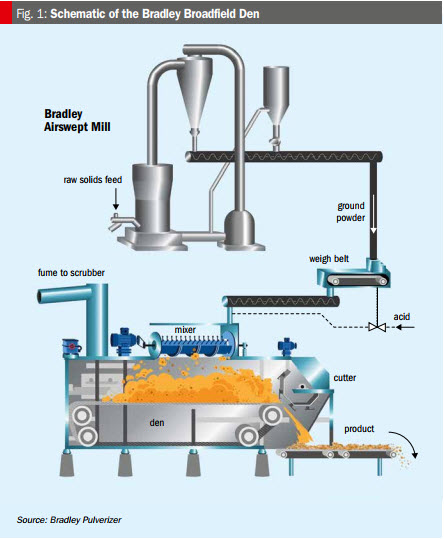 The Broadfield Den is a turnkey system specifically designed to continuously acidulate inert phosphate rock into water soluble superphosphate (Figure 1). In detail, it is actually comprised of a series of individual and interlocking equipment systems. Ultimately, proper calibration and maintenance of this entire system is required to ensure continuous production and profitable operation.
The Broadfield Den is a turnkey system specifically designed to continuously acidulate inert phosphate rock into water soluble superphosphate (Figure 1). In detail, it is actually comprised of a series of individual and interlocking equipment systems. Ultimately, proper calibration and maintenance of this entire system is required to ensure continuous production and profitable operation.
The information provided in this article assumes ‘typical working conditions’ based on general operational experience. In practice, however, each Broadfield Den is individually engineered for optimal output. Units are designed to meet the conditions specified by the end user, as well as the results of laboratory trials and testing, with confirmation of raw material composition being of primary importance.
Superphosphate production begins with the grinding of insoluble phosphate rock (mainly fluorapatite, Ca3(PO4)2CaF2) to a fine powder. This upstream process is carried out by a milling system, such as the Bradley BM20 Airswept Roller Mill, to generate phosphate rock particles of specified fineness (Figure 2). Typically, for sedimentary rock, the specified size is 75-90 percent passing 75µm (200 Tyler mesh), whereas igneous rock, due to its lower reactivity, is typically ground finer to 90+ percent passing 53µm.
Grinding significantly increases the particle surface area available for decomposition by acid. The finer the phosphate rock is ground, the faster the rate of reaction will be. The mill allows particle fineness to be adjusted to allow for differences in rock reactivity, so ensuring that adequate surface area is available for proper acidulation.
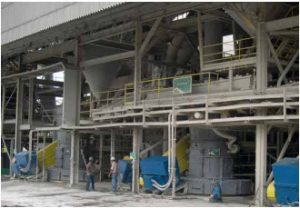
Figure 2. Upstream milling system, Brazil.
Mills which include properly specified and integrated classification systems enable more precise control of particle fineness – which requires adjustment for different rock types. Typically speaking, a properly maintained mill system will generate consistent particle size and yield rates, unless or until changes are introduced, such as differences in rock type.
The phosphate rock powder obtained is decomposed in two steps:
- Firstly, dilute sulphuric acid reacts with part of phosphate rock to produce phosphoric acid. This reaction step takes place mainly in the Broadfield Mixer.
- The free phosphoric acid produced then reacts with the remaining phosphate rock to produce monocalcium phosphate. This step takes place mainly in the Broadfield Den.
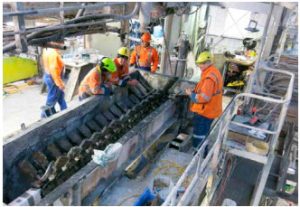
Figure 3. Broadfield mixer unit, Ballance Agri-Nutrients, New Zealand.
The first SSP reaction step occurs as soon as the diluted sulphuric acid (produced on-site) comes into contact with rock particles within the Broadfield Mixer (Figure 3), and takes just 1-2 minutes at typical rock fineness. The reaction is exothermic and releases steam, CO2 and SiF4 into the vapor space above the paddles. The paddles use shear forces to constantly create new reaction surfaces. This helps to minimize any reaction slowdown due to calcium sulphate deposition on unreacted rock particles.
The reaction slurry solidifies at the exit to the mixer and is discharged into the Broadfield Den. Mixer settings ensure that the slurry spreads evenly across the den to give a level cake. Variations in the chemical analysis and temperature of the reactants, and in rock size analysis, must be minimized to allow good operation. The operator has tools at his disposal – such as the variable speed mixer drive and paddle design – to use in response to any change in mixer conditions.
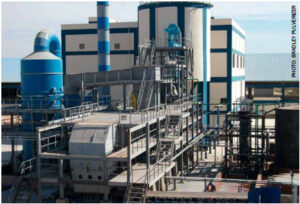
Fig. 4- Complete Broadfield process unit, Aswan, Egypt
The second part of the reaction takes place in the Broadfield Den (or Broadfield Belt Den). This is where the slurry solidifies into a cake and can take from 10-60 minutes (average 40 minutes), depending on the rock type and grinding fineness.
The Broadfield Den unit is a rugged, gas-sealed, continuous, metal slat conveyor which moves slowly in a horizontal plane. It prevents the slurry from sticking to the sides by incorporating reciprocating sides at the inlet. Inside the unit, the reaction mass is kept in one block to minimize heat loss and maximize reaction rate. (Maintaining temperature is important as reaction rate typically doubles with every 10°C.) The conveyor of the Broadfield Belt Den differs from that of the original Broadfield Den, with a rugged polyurethane belt replacing the metal slats. Both units have similar reaction times. However, while relatively easy to maintain and clean, the Belt Den runs into capacity limitations above 30 t/h.
At the end of the den, a continuous rotary cutter is used to disintegrate the reaction mass and shave off SSP powder. This falls onto a wide, slow moving cutter belt which then passes through a gas-sealed transfer point for storage and final reaction outside of the Den. The floor of the Den is inverter driven. This avoids overloads during emergency shutdowns by allowing the hardened reaction mass to be fed slowly to the cutter.
Disintegrated SSP generated by the rotary cutter is transported to storage for the final curing stage. Curing allows the reaction to reach its end point and reduces residual free phosphoric acid (Figure 5). Sufficient storage capacity is required to ensure that the bagging machines (or granulation plant) have enough SSP powder to handle after an average curing period of 15 days, or at least 10 days minimum.
An exhaust fan extracts fluoride-containing gases from the mixer and the den and sends these to a gas scrubbing system where a series of water sprays remove fluoride from the air stream. This generates HFA (hydrofluosilicic acid – H2SiF6) solution which is recycled back to the SSP/TSP mixer to provide fluorine for acidulation. This closed loop system is unique to the Bradley Broadfield Den.
The overall process for TSP manufacture is essentially the same. In fact, the Broadfield process uses the same den for both SSP and TSP production, although smaller turbine or cone mixers are used for TSP as the reaction is much faster. TSP powder takes 1-2 weeks to cure and can then be granulated as a straight or blended fertilizer with standard equipment.
Continue to Part 5 – Operational Considerations for Optimal SSP Manufacturing in the Broadfield Process
Contact Us and we will design a Broadfield Process to manufacture your superphosphates.
(US) 855-670-8777 | (International) 44-0808-196-8141

